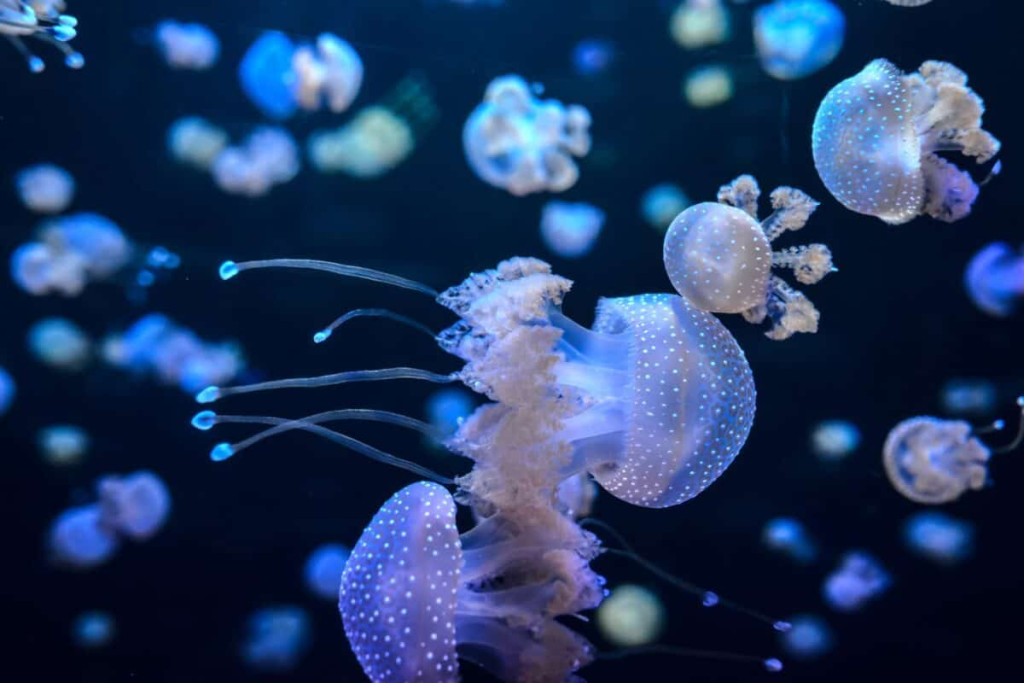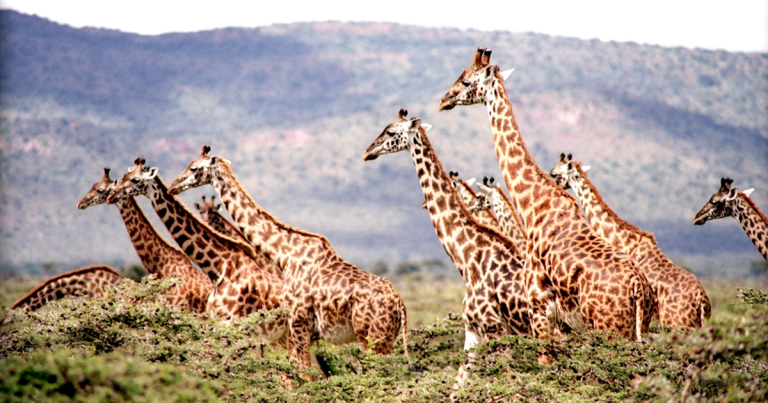What Do Jellyfish Eat and How Do They Eat It? A Deep Dive Into Their Surprising Diet
Introduction: The Mystery Behind a Creature With No Brain
Jellyfish have existed for more than 500 million years—long before dinosaurs, trees, or even insects appeared on Earth. Despite lacking a brain, bones, and complex organs, jellyfish survive in every ocean on the planet. Their success raises a simple yet fascinating question: What do jellyfish eat and how do they eat it?
Most people view jellyfish as passive drifters, floating wherever the currents push them. But this image is misleading. Jellyfish are highly effective hunters with a diet more varied—and more surprising—than many expect. Some survive on microscopic plankton. Others eat shrimp, fish, and even other jellyfish. A few species can take down prey nearly as large as themselves.
This 3,000-word deep dive explores everything about their feeding habits—from the creatures they target, to their unique biological weapons, to how different species have adapted to thrive in diverse ocean environments.
What Jellyfish Eat: A Detailed Look at Their Diverse Diet
Jellyfish diets vary greatly depending on species, size, age, and habitat. Still, several major food categories appear across most species.
1. Plankton: The Foundation of the Jellyfish Diet
Plankton is the ocean’s microscopic world, and for many jellyfish, it forms the bulk of their diet. Species like moon jellyfish (Aurelia aurita) primarily consume small organisms drifting with the current.
They eat:
• phytoplankton
• zooplankton
• copepods
• amphipods
• fish larvae
• crab larvae
• marine worm larvae
This diet makes jellyfish important players in regulating plankton populations, especially during seasonal blooms.
A surprising fact: a single moon jelly can consume thousands of planktonic organisms per day when conditions are right.
2. Small Fish and Fish Larvae
Larger species—such as sea nettles and lion’s mane jellyfish—regularly consume small fish.
Examples include:
• anchovy larvae
• juvenile sardines
• small reef fish
• herring fry
These small fish become entangled in tentacles before they even recognize danger. Some jellyfish have tentacles extending more than 100 feet (30 m), giving them a massive hunting reach.
3. Shrimp and Other Crustaceans
Crustaceans are a favorite target of medium and large jellyfish species.
Common prey include:
• juvenile shrimp
• krill
• mysid shrimp
• copepods (technically crustaceans too)
In fact, in waters where shrimp populations explode, jellyfish populations often follow—because the extra food supports rapid growth.
4. Fish Eggs
Many gelatinous species are opportunistic feeders and will quickly consume fish eggs floating near the surface. Fish eggs are high in fat, protein, and nutrients—making them a perfect snack that requires minimal effort to capture.
5. Other Jellyfish: Cannibalism in the Deep
Cannibalism is surprisingly common among jellyfish.
Larger species often feed on:
• smaller jellyfish
• jellyfish larvae
• fragments of dead jellyfish
The lion’s mane jellyfish, for example, is notorious for eating smaller jellies trapped in its long, hair-like tentacles.
6. Detritus and Dead Organic Material
Some jellyfish, especially in nutrient-poor waters, will consume decaying matter. They do not actively hunt for it; instead, they capture particles that drift into their tentacles or oral arms.
7. Algae and Microbes
A few species have symbiotic algae living inside their tissues. These algae produce food through photosynthesis, giving the jellyfish an extra energy source.
This unique diet strategy appears in species like Cassiopea, known as the “upside-down jellyfish.”
How Jellyfish Eat: The Science Behind Their Feeding Mechanism
Understanding what jellyfish eat is only half the story. The real mystery lies in how they eat, especially since they lack a brain, eyes (in most species), and traditional organs.
Their feeding system is simple yet remarkably effective.
Step 1: Detecting Prey Without Eyes or a Brain
Most jellyfish do not “see” prey. Instead, they rely on:
• chemical sensors in their tentacles
• vibrations in the water
• random drift movements that bring prey into contact with them
A jellyfish hunts passively but efficiently, using the ocean’s movement as a transportation and hunting system.
Step 2: Capturing Prey With Tentacles
When prey touches a tentacle, it triggers millions of microscopic stinging cells called nematocysts. These cells act like spring-loaded harpoons.
Each nematocyst contains:
• a coiled thread
• toxins
• a pressure-sensitive trigger
When activated, the thread shoots out faster than a bullet and injects venom into the prey. This process happens in less than a millionth of a second, making nematocysts one of the fastest mechanisms in nature.
Step 3: Immobilizing Prey
Venom varies by species.
Some effects include:
• paralysis
• muscle spasm
• nerve disruption
• tissue breakdown
In mild jellyfish, the toxins only stun tiny plankton.
In deadly species like the box jellyfish, toxins can kill fish in seconds.
Step 4: Moving Food to the Mouth
Once the prey is immobilized, the tentacles curl inward and pull it toward the jellyfish’s mouth, located on the underside of the bell.
Some jellyfish also use oral arms—frilly, curtain-like structures that help transport food.
Step 5: Digestion Inside the Gastrovascular Cavity
The jellyfish mouth leads to the gastrovascular cavity, where digestion occurs.
Inside this cavity:
• enzymes break down food
• nutrients are absorbed
• remaining waste is expelled back out through the mouth (yes, jellyfish eat and poop from the same opening)
This simple digestive system is surprisingly efficient.
Step 6: Growth Through Constant Feeding
Jellyfish grow rapidly. For example, a juvenile moon jelly only a few millimeters wide can grow to 12 inches (30 cm) across in a single season—powered entirely by these simple feeding processes.
How Different Jellyfish Species Eat Differently
Not all jellyfish eat the same way. Their feeding techniques vary widely depending on shape, tentacle length, mobility, and venom strength.
1. Moon Jellyfish (Aurelia aurita)
Moon jellies use mucus on their bell surface to trap plankton, then move it to their mouth via cilia. They are filter feeders more than predators.
2. Sea Nettle Jellyfish
These species use long tentacles with strong stings to capture crustaceans and small fish.
3. Lion’s Mane Jellyfish
Growing up to 120 feet in tentacle length, they form massive nets capable of capturing entire schools of small fish.
4. Box Jellyfish
The world’s most venomous jellyfish, capable of actively swimming and visually locating prey thanks to true eyes.
They eat fast, agile prey like fish.
5. Upside-Down Jellyfish (Cassiopea)
These jellies rely on photosynthetic algae, meaning they “farm” their own food—similar to corals.
6. Comb Jellies (Not True Jellyfish)
Although commonly mistaken for jellyfish, they use sticky cells called colloblasts, not stinging cells. Their diet focuses on plankton and smaller comb jellies.
How Baby Jellyfish (Ephyrae) Eat
Baby jellyfish have smaller tentacles and weaker stinging cells, so their diet is limited to microscopic organisms.
They eat:
• rotifers
• very small crustaceans
• tiny zooplankton
As they grow into adults, their diet broadens significantly.
How Jellyfish Eating Habits Affect Ocean Ecosystems
Jellyfish feeding has surprisingly large effects on oceans.
1. Controlling Plankton Populations
By eating billions of planktonic organisms, jellyfish help regulate population booms—maintaining balance in marine ecosystems.
2. Impacting Fish Populations
Because they eat fish eggs and larvae, jellyfish can influence local fisheries. Large jellyfish blooms sometimes devastate young fish populations.
3. Competing With Fish
In some regions, jellyfish compete directly with fish for plankton.
This competition grows stronger when:
• water warms
• predators of jellyfish decline
• overfishing removes large fish
4. Providing Food for Other Animals
Jellyfish are preyed upon by:
• sea turtles
• ocean sunfish (Mola mola)
• some seabirds
• larger jellyfish
• certain fish species
Their soft bodies make them easy to swallow, even if not nutritionally dense.
5. Boosting Biodiversity
Jellyfish carcasses that sink to the seafloor—known as “jelly-falls”—feed deep-sea organisms like crabs, worms, and scavenging fish.
How Often Do Jellyfish Eat?
Feeding frequency depends on:
• species
• temperature
• food availability
• age
Some jellyfish eat continuously as food drifts into their tentacles. Others slow down in colder waters. Many species can survive weeks without eating, thanks to slow metabolisms.
How Much Do Jellyfish Eat in a Day?
A rough estimate:
A medium-sized jellyfish may eat small prey equal to its body mass every 24 hours when food is abundant.
In captivity, a single sea nettle can consume dozens of brine shrimp per day.
Do Jellyfish Eat Humans?
No. Jellyfish cannot bite, chew, or intentionally pursue humans. Their stings are defensive or accidental. Even the most dangerous species only aim to incapacitate small fish.
Do Jellyfish Eat Plastic?
Jellyfish do not intentionally eat plastic, but microplastics often stick to their mucus or get trapped in their tentacles. This contributes to the spread of plastic pollution through the food chain.
Why Understanding Jellyfish Diets Matters
Studying jellyfish diets helps scientists predict:
• jellyfish population booms
• fishery impacts
• climate change effects
• ocean health indicators
Because their populations respond quickly to environmental changes, jellyfish are considered “indicator species.”
Conclusion: A Simple Body With a Surprisingly Complex Diet
Despite lacking a brain, jellyfish are skilled feeders that play vital roles in ocean ecosystems. Their diet is more diverse than most people imagine, ranging from microscopic plankton to shrimp, fish, and even other jellyfish. Their feeding process—powered by some of the fastest stinging cells in nature—shows how evolution creates elegant solutions without complexity.
Understanding what jellyfish eat and how they eat it not only reveals the biology of one of the world’s oldest creatures, but also helps scientists better understand the health and stability of our oceans.
FAQ: Everything You Want to Know About What Jellyfish Eat and How They Eat It
1. What exactly do jellyfish eat?
Jellyfish are opportunistic predators, which means they eat anything that drifts into their tentacles. Most species primarily feed on plankton, tiny crustaceans like shrimp and copepods, fish eggs, larvae, and even smaller jellyfish. Some larger species, like the lion’s mane jellyfish, can capture small fish and other invertebrates. Certain species, such as the upside-down jellyfish, also gain energy from symbiotic algae living within their tissues.
2. How do jellyfish capture their prey?
Jellyfish use specialized stinging cells called nematocysts located on their tentacles. These microscopic harpoons inject venom into the prey, paralyzing or killing it almost instantly. The tentacles then pull the immobilized prey toward the oral arms, which transport it to the jellyfish’s mouth for digestion.
3. Can jellyfish eat large prey?
Most jellyfish feed on tiny organisms, but some species are capable of eating surprisingly large prey relative to their size. For instance, the lion’s mane jellyfish has tentacles that can exceed 100 feet, allowing it to capture small fish and other jellyfish. Box jellyfish actively hunt small fish and shrimp, using their venom to subdue prey.
4. Do all jellyfish sting their prey?
Not all jellyfish rely equally on stinging. Some, like moon jellyfish, have mild stings and mostly use mucus on their tentacles to trap plankton. Others, like box jellyfish or Portuguese man o’ war, have potent venom capable of quickly immobilizing small fish. In essence, the stinging strength and hunting style vary significantly between species.
5. How do baby jellyfish eat?
Baby jellyfish, called ephyrae, have smaller tentacles and weaker stinging cells. They primarily feed on microscopic plankton, rotifers, and small copepods. As they grow into adult medusas, their tentacles lengthen and become stronger, allowing them to capture larger prey.
6. Can jellyfish survive without food?
Yes. Jellyfish have low metabolic rates and can survive weeks or even months without food. During periods of scarcity, they may shrink in size in a process known as “degrowth” and resume normal growth when food becomes plentiful.
7. Do jellyfish eat each other?
Cannibalism is common among jellyfish. Larger species may consume smaller jellyfish or fragments of dead jellies. For example, the lion’s mane jellyfish frequently captures smaller jellyfish with its long tentacles, supplementing its diet when other prey is scarce.
8. Do jellyfish eat humans or pose a threat to people as food?
No. Jellyfish cannot intentionally consume humans. Their stings are primarily for subduing small prey. While some jellyfish stings can be painful or dangerous to humans, they do not view humans as prey.
9. Do jellyfish eat plastic or other pollutants?
Jellyfish do not intentionally consume plastic. However, microplastics can become entangled in their mucus or tentacles, which can then enter the marine food chain if predators eat the jellyfish. This is a growing concern for marine ecosystems affected by plastic pollution.
10. How much do jellyfish eat in a day?
The amount varies by species, size, and food availability. A medium-sized jellyfish can consume prey roughly equal to its body mass every 24 hours if food is abundant. For smaller species like moon jellyfish, this could mean thousands of planktonic organisms per day.
11. How do jellyfish digest their food?
Jellyfish use a simple sac-like digestive cavity called a gastrovascular cavity. Prey enters the mouth, enzymes break down soft tissues, nutrients are absorbed through the cavity walls, and indigestible materials are expelled back through the mouth. This system is efficient despite its simplicity.
12. Can jellyfish regulate what they eat, or do they just consume whatever drifts by?
Jellyfish are mostly passive feeders. They cannot actively hunt in the way fish do (with exceptions like box jellyfish that can swim and actively pursue prey). They rely on ocean currents to bring prey into contact with their tentacles. Still, they can selectively capture prey that triggers their stinging cells.
13. How do environmental changes affect jellyfish diets?
Changes like ocean warming, overfishing, and nutrient pollution can alter the availability of food. Jellyfish populations often thrive in disturbed ecosystems because they can feed on whatever is abundant, whether it’s plankton blooms caused by nutrient runoff or fish larvae left vulnerable by declining fish populations.
14. How do jellyfish blooms impact other marine life?
When jellyfish populations explode, they consume massive amounts of plankton and fish larvae, which can decrease fish populations and disrupt ecosystems. Blooms can also clog fishing nets, damage aquaculture operations, and reduce biodiversity in localized areas.
15. Do jellyfish contribute to ocean ecosystems despite eating other creatures?
Absolutely. Jellyfish are integral to marine food webs. They regulate plankton populations, serve as prey for sea turtles, ocean sunfish, and certain fish, and recycle nutrients when they die. Jellyfish carcasses sinking to the ocean floor, known as “jelly-falls,” provide food for deep-sea organisms.
16. Can humans feed jellyfish in aquariums?
Yes. Captive jellyfish are typically fed brine shrimp, cultured plankton, rotifers, and other small organisms. Feeding must be frequent, as jellyfish are delicate and rely on constant access to appropriately sized prey to grow and thrive.
17. Are all jellyfish diets purely carnivorous?
Not entirely. Some species, like upside-down jellyfish (Cassiopea), rely partly on photosynthetic algae living inside them. These algae produce energy through photosynthesis, supplementing the jellyfish’s diet. In effect, some jellyfish can “farm” their own food in combination with traditional prey consumption.
18. How do jellyfish diets affect humans directly?
Jellyfish diets impact humans in several ways. Large blooms can reduce fish populations, affecting fisheries and commercial fishing. They can also create hazards for swimmers and clog water intake systems at coastal facilities. Understanding jellyfish feeding habits helps scientists predict and mitigate these impacts.
19. How do jellyfish compete with fish for food?
Jellyfish and many fish species consume plankton and fish larvae. When jellyfish numbers increase, they compete for these same food resources, sometimes leading to reduced survival rates for juvenile fish. This competition can affect fishery yields and ecosystem balance.
20. Why is studying jellyfish diets important for ocean science?
Studying what jellyfish eat and how they feed provides insights into ecosystem health, the effects of climate change, the impact of overfishing, and shifts in nutrient availability. Because jellyfish respond rapidly to environmental changes, they act as early indicators of oceanic shifts, helping scientists anticipate broader ecological consequences.










